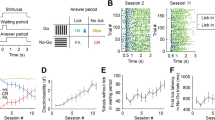Abstract
Impulse activities were recorded from neurons of the sensorimotor cortex of cats, trained to perform a conditioned placing reaction, before, during, and after iontophoretic application of the synaptically active drugs dopamine (DA) and GABA. Our experiments demonstrated that in most cases isolated application of DA increased the frequency of the impulse activity and the number of spikes related to the placing reaction. On the other hand, GABA evoked decreases in both indexes characterizing the impulse activity. In the case of co-application of DA with GABA, we observed both increases and decreases in the background firing rate activity and in the number of spikes related to the placing reaction. Our results suggest that interaction between the DA-ergic and GABA-ergic systems is realized at the receptor level and cannot be interpreted in an oversimplified manner.
Similar content being viewed by others
REFERENCES
R. J. Beninger, “The role of dopamine in locomotor activity and learning,” Brain Res. Rev., 6, 173–196 (1983).
B. Berger, P. Gaspar, and C. Verney, “Dopaminergic innervation of the cerebral cortex: unexpected differences between rodents and primates,” TINS, 14,No 1, 21–27 (1991).
S. R. Sesack, C. L. Snyder, and D. Lewis, “Axon terminals immunolabeled for dopamine or tyrosine hydroxylase synapse on GABA-immunoreactive dendrites in rat and monkey cortex,” J. Comp. Neurol., 363, 264–280 (1995).
F. M. Zhou and T. T. Hablitz, “Dopamine modulation of membrane and synaptic properties of interneurons in rat cerebral cortex,” J. Neurophysiol., 81, 967–976 (1999).
S. Pirot, R. Godbout, J. Mantz, et al., “Inhibitory effects of ventral tegmental area stimulation on the activity of prefrontal cortical neurons: evidence for the involvement of both dopaminergic and gabaergic components,” Neuroscience,49,No. 4, 857–865 (1992).
M. Camps, P. H. Kelly, and J. M. Palacios, “Autoradiographic localization of dopamine D1 and D2 receptors in the brain of several mammalian species,” J. Neural. Transm. Gen. Sect., 80,No. 2, 105–127 (1990).
Y. Ohno, M. Sasa, and S. Takaori, “Coexistence of inhibitory dopamine D-1 and escitatory D-2 receptors on the same caudate nucleus neurons,” Life Sci., 40,No. 19, 1937–1945 (1987).
K. Huda, T. L. Salunga, S. A. Chowdnury, et al., “Dopaminergic modulation of transcallosal activity of cat motor cortical neurons,” Neurosci. Res., 33,No. 1, 33–40 (1999).
T. Sawaguchi, M. Matsumura, and K. Kubota, “Catecholaminergic effects on neuronal activity related to a delayed response task in monkey prefrontal cortex,” J. Neurophysiol., 63,No. 6, 1385–1400 (1990).
B. Floran, J. Aceves, A. Sierra, et al., “Activation of D1 dopamine receptors stimulates the release of GABA in the basal ganglia of the rat,” Neurosci. Lett., 116,Nos. 1/2, 136–140 (1990).
Author information
Authors and Affiliations
Corresponding author
Rights and permissions
About this article
Cite this article
Rozumna, N.M. Interaction between the Dopaminergic and GABA-ergic Systems of the Cortex during Conditioning. Neurophysiology 34, 213–215 (2002). https://doi.org/10.1023/A:1020771804592
Issue Date:
DOI: https://doi.org/10.1023/A:1020771804592




